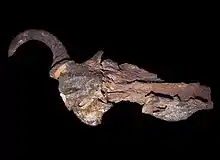Megalotragus
Megalotragus was a genus of very large extinct African alcelaphines that occurred from the Pliocene to early Holocene.[1][2] It's skull resembled that of modern hartebeests, but differed in larger body size and proportions. Megalotragus includes some of the largest bovid species in the tribe Alcelaphini, reaching a shoulder height of 1.4 m (4.6 ft). The genus consists of three species of which Megalotragus priscus survived until the early Holocene 7.500 C14yBP.[2]
| Megalotragus | |
|---|---|
 | |
| Megalotragus kattwinkeli skull | |
| Scientific classification | |
| Kingdom: | Animalia |
| Phylum: | Chordata |
| Class: | Mammalia |
| Order: | Artiodactyla |
| Family: | Bovidae |
| Subfamily: | Alcelaphinae |
| Tribe: | Alcelaphini |
| Genus: | †Megalotragus van Hoepen, 1932 |
| Species | |
Description
The skull of Megalotragus is similar to that of the hartebeest: characterized by extreme elongation, and the fusion and posterior of the horn pedicels. However, it's postcrania and proportions are largely reminiscent of wildebeest: for instance, axes from Megalotragus are robust and compact, suggesting it had a robust, muscular neck that was likely held horizontally, much like black wildebeest.[3]
See also
References
- Turvey, S.T. (2009). Holocene mammal extinctions. In: Turvey, S.T. (editor) (2009). Holocene extinctions. Oxford University Press, Oxford, UK.
- Thackeray, John Francis. (2015). Faunal Remains from Holocene Deposits, Excavation 1, Wonderwerk Cave, South Africa. African Archaeological Review.
- Brink, J.S. (2005). The Evolution of the Black Wildebeest, Connochaetes gnou, and Modern Large Mammal Faunas in Central Southern Africa (PDF) (PhD). University of Stellenbosch.
